Sales and Marketing Automation: How to align their workflow to 2x revenue [Dashly example]
![Sales and Marketing Automation: How to align their workflow to 2x revenue [Dashly example]](https://www.dashly.io/blog/wp-content/uploads/2021/06/IMG_1074-1100x471-1.jpg)
We all know that the sales team’s major KPI is the number of closed deals, while the marketing team’s one is the number of leads collected. In pursuit of their KPIs, marketers often acquire so cold leads that sales reps will never sell anything. That sets off a lose-lose battle where marketers spend thousands of dollars on low-quality campaigns and sales reps waste time on customers who won’t buy anything.
The fix?
Sales and marketing automation.
We’ve talked to Polina, Growth Marketer, and Paul, Head of Sales at Dashly to learn from their experience. Together will discover mistakes in marketing and sales processes and how they approached them with automation.
Spoiler: Instead of hiring an extra sales force and wasting money on ads, the teams aligned on their collaboration and sales and marketing automation software.
You can watch the video or read the article below.
Mistake 1: Implementing sales and marketing automation with zero knowledge about the entire customer journey
Lead generation is usually the responsibility of marketers. They pass the collected leads to sales reps. The challenge is that both teams have no idea of what’s going on with a customer at other stages.
Sales reps don’t know if leads collected by marketers are hot or cold, and marketers don’t know what happens with their leads later as they continue running ads and collecting low-quality leads who don’t buy anything.
When a sales rep calls 100 people and only talks to five of them, it’s frustrating and discouraging. It just means wasting your life on calls that are screened on the other side. Marketing and sales teams should collaborate to avoid that frustrating situation. Sales reps should give feedback to marketers after calling the leads. This will help improve the performance of marketing campaigns and increase sales without hiring an additional sales force.
How it used to be
There are two major funnels in Dashly marketing automation.
- Self-service: a user journeys from signing up to paying for the platform independently. It’s also called an auto funnel.
- Sales funnel: after a user signs up, a sales rep calls to convert them to a paid plan.
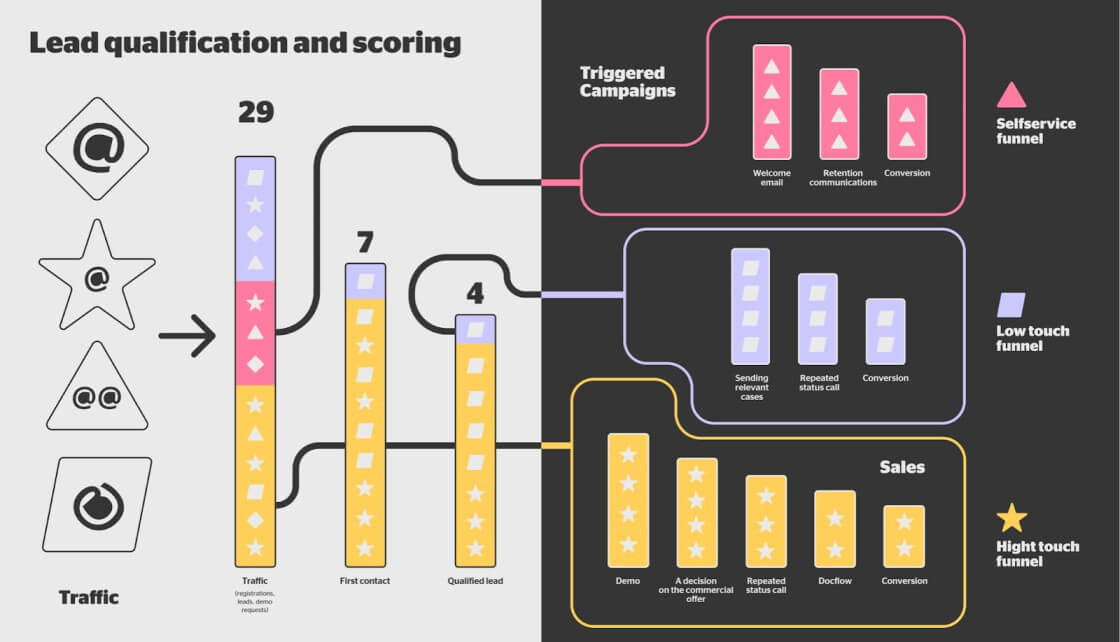
Marketers didn’t even think about that part of the funnel that the sales reps were in charge of. This year, we looked at how leads converted to payment and it dawned on us that team collaboration is definitely a growth area for us.
How we fixed that:
We built our current funnel in marketing and sales. Using a board in Miro, we described how leads converted to signups and demos and what sales reps were doing at each stage. We also measured the current conversion rates of all stages.
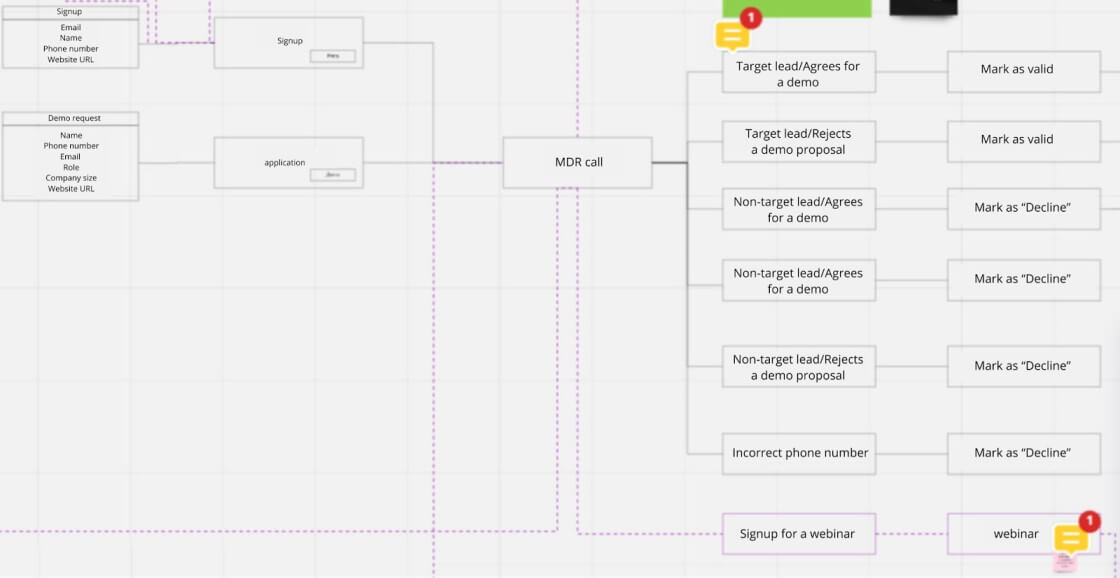
Part of the marketing automation funnel where marketers passes users to sales.
I fully appreciate how the funnel is working and how I influence the company’s revenue. When I know what happens to leads that I collect, I am able to plan my work because I see what works and what doesn’t. I can truly see what may bring success or not.
When marketers explored how the sales team dealt with customers, they implemented automation to pass leads to sales:
- They warn sales about the upcoming lead campaign. Sales reps have their day-to-day tasks, and they can’t just give up their work to call 400 leads quickly.
- Marketers tell more about the campaign to make calls effective. Sales reps should know about the offer to see what interests their leads.
- When qualifying a lead, you should determine their role in a company so sales reps know how to talk to them. Your lead may be a product manager, a marketer, sales team lead, support team lead, or even a CEO.
- Marketers inform sales reps about the campaign’s start in a special Slack channel. They tell who they are acquiring, how many, and when sales reps need to call them.
Marketers also need to specify the SLA. When the sales team approves it, marketers start the campaign.
We created a marketing automation checklist in Notion:
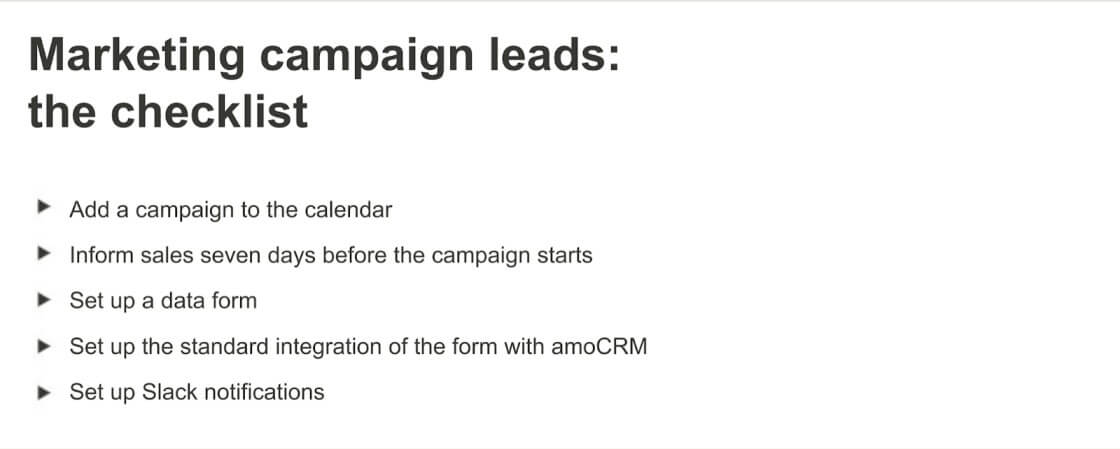
Leads go from Dashly to amoCRM via the standard marketing automation integration
The sales team also rearranged some processes. They assigned an MDR — a manager responsible for primary lead qualification. If a user leaves their real phone number, a manager calls them to find out their objectives, traffic volume, and role in a company.
If we can solve the user’s tasks — an MDR schedules a demo session and assigns the lead to another sales rep for a more detailed conversation.
I once had an amazing revelation: there’s life in sales! Customers got things going on! If they don’t sell, users still convert to signing up and payments much better after they talk to our sales reps. That’s why I would say guiding people through sales is cool.
2x your sales conversions by contacting
the most promising leads first
with Dashly AI chatbot
Mistake 2: Sales and marketing managers are not hypothesizing together
Teams working asynchronously set different objectives. Marketers launch campaigns and collect leads, and sales do their best to convert leads to deals. When a company can’t generate the desired revenues, the question arises: are sales reps bad at their work, or do marketing automation collects low-quality leads?
Marketing and sales teams should have mutual hypotheses so sales can get better prepared for the campaign and appreciate the hypothesis. It’s important to listen to each other so sales don’t just call leads like robots, but rather give feedback on which hypotheses worked and which didn’t
How it used to be
Marketers only cared about metrics in advertising accounts and had no clue about what was happening to their leads. The team didn’t know how much they were going to earn. Hence, the team didn’t know how much they could invest in advertising.
Read also: Discover the Purpose of a Funnel: 10 Benefits for 2025
How we fixed that
We approached our marketing campaigns differently.
You need to know your sales funnel metrics to budget your marketing automation. The teams learned about unit economics. Each campaign is treated as a hypothesis. Marketers know their key metrics on each stage, and how many leads will convert to buying. This helps us avoid campaigns that we know will not pay off. Some campaigns only need to be launched if our sales team works on the leads.
Hypothesis example:
If we run a retargeting campaign in Facebook Ads saying “Learn to increase the number of leads using Dashly” and collect demo requests in the Facebook lead form using automatic placements with a static image, we’ll get five demo requests for less than $10.
Mistake 3: Sales managers don’t share feedback on leads
When marketing passes leads to sales, we need to know if we collected quality leads. We can collect many leads that won’t convert. This campaign should be stopped in time so that the team’s time and money are not wasted.
How it used to be:
Marketers passed leads to sales in a chaotic manner:
We did a webinar →
We saw how many people signed up after it →
The very few of them did →
What should we do next?
We decided to ask sales to call these leads. But sales reps told us that these leads were bad.
This is not constructive feedback. Not all 400 leads were bad, but the marketing team couldn’t get higher quality feedback.
How we fixed that:
We created a ritual to teach teams to give feedback. The ritual was called “the lead committee”.
Marketing and sales teams participated in these meetings. Sales reps reported all leads they got from the marketing team over the last one or two weeks.
Then, teams discussed how many leads are on a particular stage of the funnel, how many of them bounced, how many deals are closed, and how the remaining leads should be processed.
It took us long to get used to it. In one of the meetings, we simply discussed how we were going to interpret the results, what was missing in the report draft, and we still continue doing it. We now see what we need in our funnel, what we should do to meet our goals, and how things work together. Both teams now understand what marketers should do to pass high-quality leads to sales.
Let’s say 80% of the campaign leads didn’t proceed to demos because they didn’t even have their websites. It means we shouldn’t scale this campaign because it brings us bad leads.
If leads are not ready for a demo yet, there’s a chance to “nurture” them. Marketers jump in on each stage, for example, sending personalized emails to each segment.
Polly’s case:
I once had a case with a messenger campaign. Metrics on the platform were not super cool. Only 11% of the audience clicked the link, and we got 15 requests for a demo. This may seem a small number. But then these 15 requests converted well. The majority of leads wanted to use our product. One deal pays off all campaign expenses. For me, this was unexpected feedback. I thought the campaign was bad, but the sales told me otherwise. Our “lead committee” is a great source of feedback where I can see how good our campaigns are.
Mistake 4: not using marketing and sales automation software for lead scoring
Marketers can collect thousands of leads in just one campaign. A sales rep’s call with a potential customer usually lasts for one hour. If all collected leads are passed to sales, they just won’t be physically able to process all of them.
That’s why we needed to evaluate leads that marketers pass to sales. This would make the sales reps’ work easier as they would know who to call first.
How Dashly campaigns leads are scored and passed to sales
We invented the term “valid lead” meaning:
- They have a website.
- They have a certain volume of traffic.
- We can engage the person.
- They have tasks that our platform can solve.
If a valid lead rejects a demo proposal from a sales rep, they go through a self-service funnel and configure the platform on their own.
If we can’t mark a lead as “valid”, we pass it to marketing for “nurturing”, and an MDR emails them:
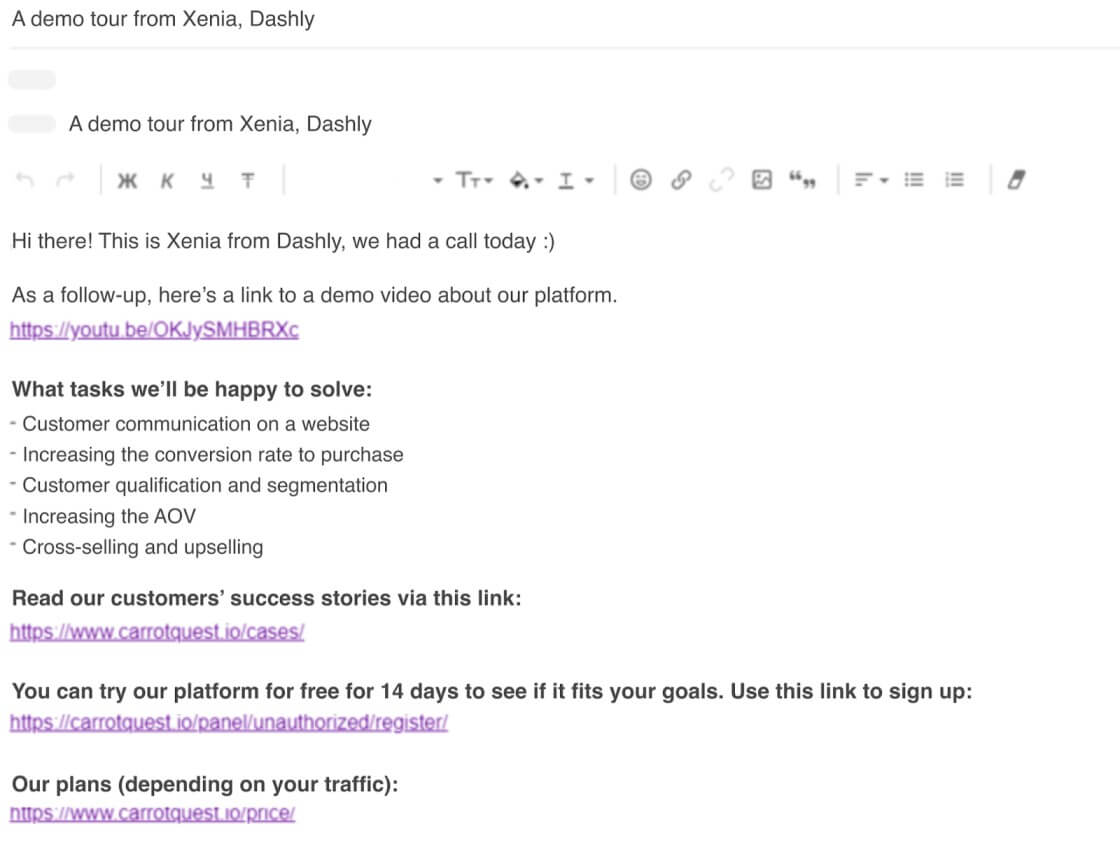
If marketers need sales reps to call certain leads, they set up Slack notifications via the integration with Dashly. These are high-priority leads for sales reps.
Automate the way you collect “valid leads”
We use our own tools for that purpose:
1. Qualification Leadbot offering a demo. If a user agrees, Leadbot qualifies them and records the data to the lead card in Dashly.
2. Score and prioritize leads with Dashly AI using answers to the qualification questions the chatbot asked clients.
3. Manage all of them them in the lead database:
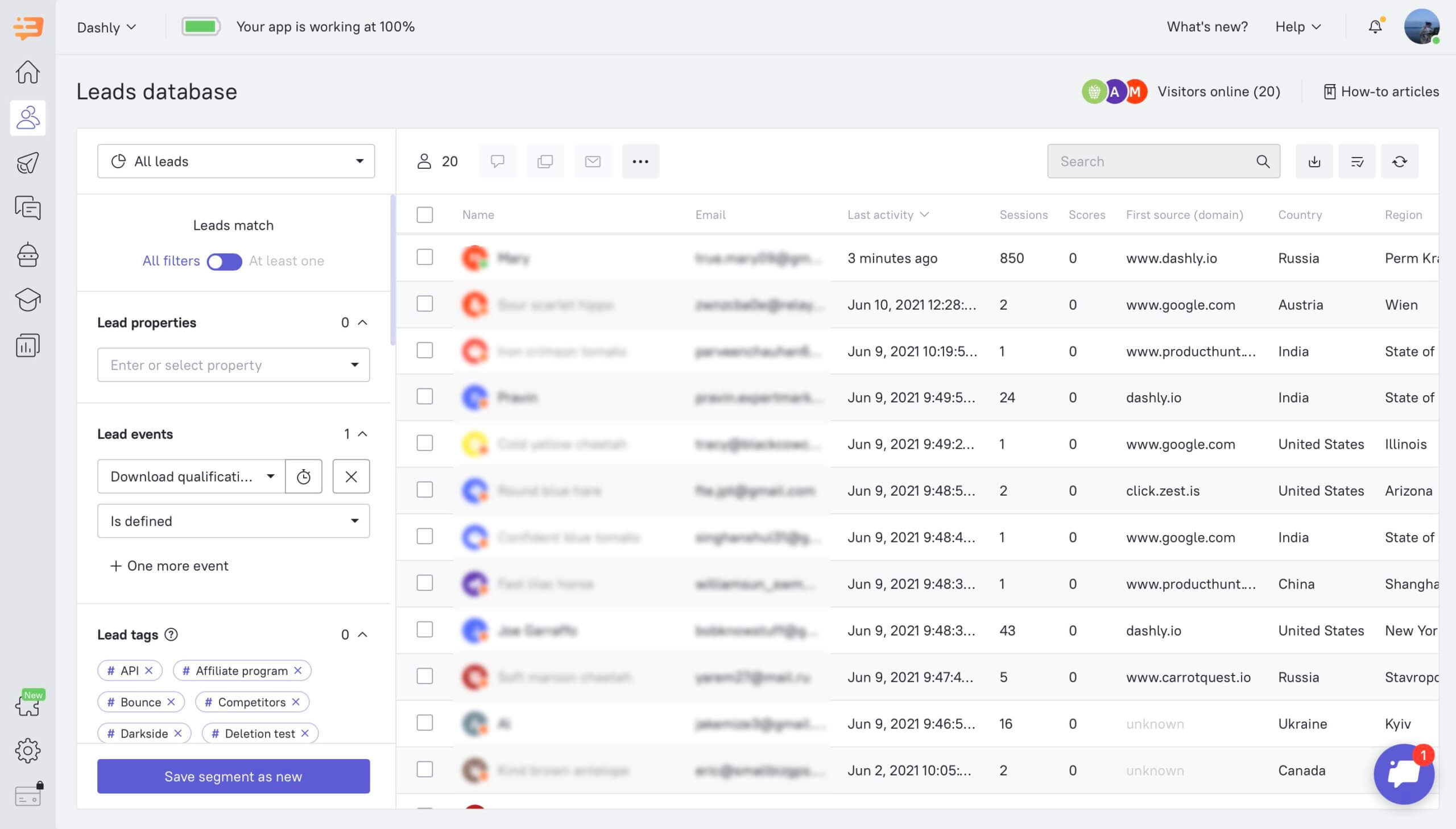
Save your SDR time with AI-powered chatbot for lead qualification, nurturing, and scoring
Collect and prioritize leads automatically
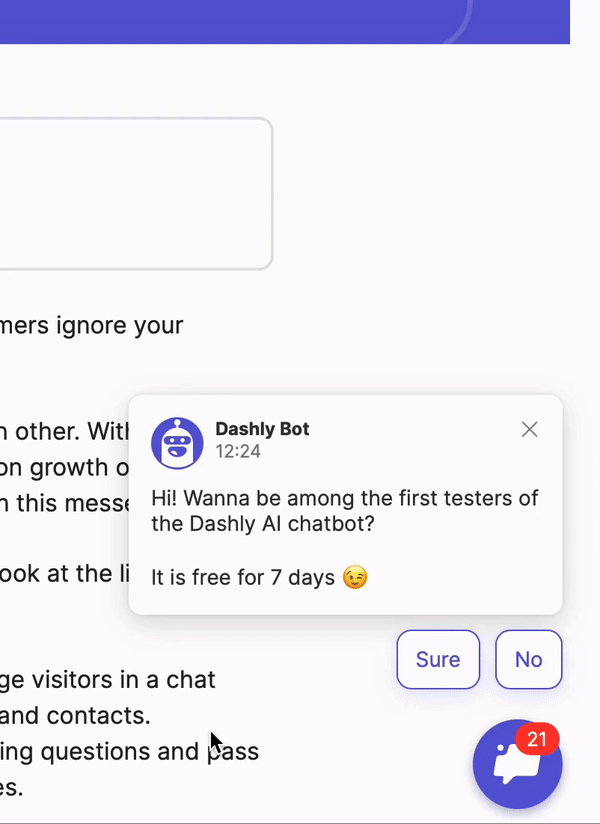
Mistake 5: having no idea of who you are selling to
When teams see the product audience differently, they set different objectives. That was our case before we described the buyer personas. If teams can’t set the right objectives, they can’t develop a customer strategy. As a result, they lose money.
How we fixed that in Dashly sales
We defined the ICP which is the Ideal Customer Profile.
For us, these are the companies:
- From a particular segment;
- Operating in particular markets;
- Having substantial website traffic;
- Having certain company roles.
The ICP concept can be used to find leads, position your product, or set up an ad campaign.
Implement sales automation with Dashly AI chatbot to qualify, score, and nurture your leads
Know everything about your clients before a sales call for better prioritization and conversion into a deal.
We mostly stick to the ICP when looking for customers. We know for sure what companies we’re looking for. We have success stories to show them and we know how to meet their needs. When we collect a lead from the ICP company, we match the person’s role to the key buyer personas. It helps us understand what tasks they have and what we can offer.
During a meeting, our sales reps can tell the lead’s objectives and their pains from similar stories. If a customer confirms that it’s their case, sales reps describe how we can solve their issues.
This model helps our marketing teams design campaigns and formulate offers to acquire new customers.
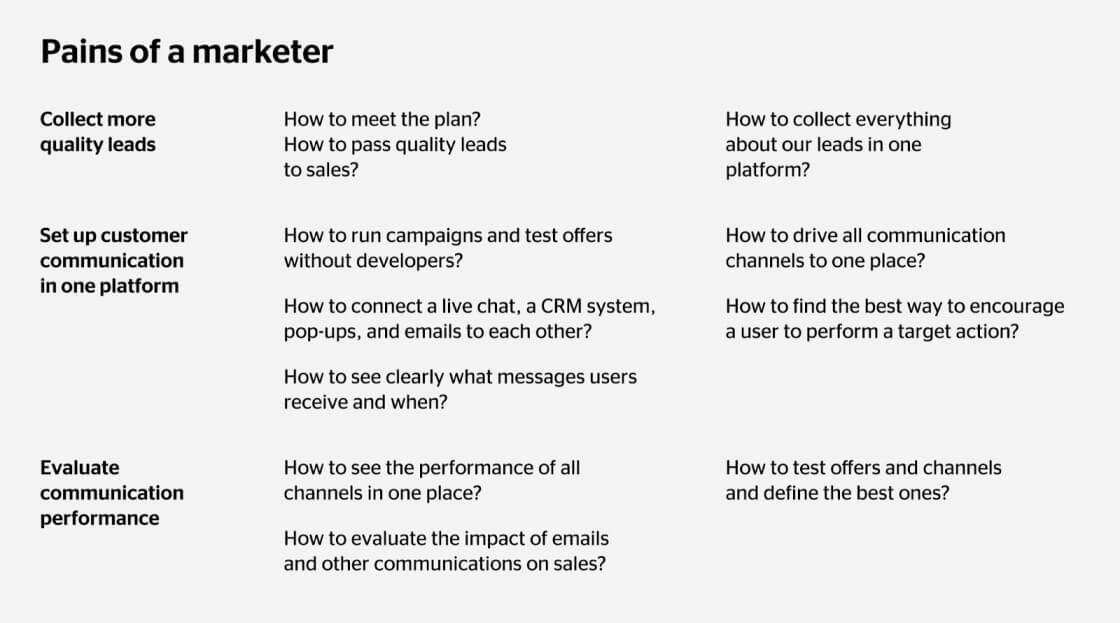
“Pains” of a marketer. This is a part of a presentation of customer pains that Dashly can cure
We wanted to work closely with sales because we did JTBD research and we found out how we can sell more. We needed to tell our sales fellows what we learned and help them sort things out.
How to deliver hot leads from marketing to sales: automation checklist
- Describe your target leads so sales reps consider them valid. Define the ICP and the buyer personas.
- Define where you can find these people and what you can offer them.
- Remove leads with incorrect data, for example, invalid phone numbers.
- Prioritize leads using these criteria.
- Find active leads, like the ones who read some of your emails. Then choose the ones who visited your website. You’ll have a list of the most and the least perspective leads to work on.
- Collect feedback from sales. Then, decide on your campaign based on metrics that are close to the end of the funnel, not the ones from your advertising account.
Advice from Paul:
Team up to sell more, that’s good for business. Even a small sales team can sell more if they work on good leads that marketers qualify. Don’t overman. Communicate and automate qualification and the process of passing leads from marketing to sales.
Let us show you how Dashly marketing automation can 2x quality leads in your pipeline

FAQ on how to automate sales and marketing workflow
Sales and marketing automation streamlines your processes, replacing manual effort with tech solutions. With marketing automation, you can auto-pilot tasks like email campaigns and lead nurturing, ensuring your team focuses on strategy and closing deals, not the busy work. Automation acts as a productivity multiplier for your marketing and sales force.
Keap tailors sales and marketing automation for your business, turning emails and campaigns into customer magnets. It handles the repetitive tasks, so your sales game stays strong. If you’re eyeing other options, Drift offers real-time chat for instant customer engagement, while Dashly.io provides lead generation and nurturing tools, both excellent alternatives for boosting your sales efforts.
Marketing automation focuses on the top of the funnel—automating emails and other marketing efforts to attract and nurture leads. It’s about prepping the customer for the pitch. On the flip side, sales force automation kicks in once leads are warm. It streamlines the sales process, managing customer data, and sealing deals. Basically, marketing automation woos them, and sales automation closes them.
Marketing automation is a game-changer, handling everything from capturing leads to scoring and qualification. It ensures seamless customer journeys, firing off emails at just the right time to nudge prospects through the funnel. By automating the legwork — like grading leads on their readiness to buy — your sales team zeroes in on hot prospects, making their pitch more efficient and effective. It’s like having a smart, silent partner in your marketing strategy.
With sales and marketing automation tools like Dashly and Drift, nurturing, qualifying, and scoring leads become a breeze. These tools smartly automate customer email interactions and lead management, ensuring your sales team can focus on real conversations that close deals. They’re the behind-the-scenes wizards, organizing your marketing efforts to help you engage with the right customers at the right time, propelling your sales forward.
Read also:
- The best way to collect emails: 5 top-notch methods unveiled
- 3-step guide on inbound lead qualification: how to qualify inbound leads on autopilot
- B2B vs. B2C Sales Funnel: Key Differences and Insights
- Acquisition funnel marketing: Grow customer conversions at each step of user journey
- 20 AI sales tools: Boost your sales strategy with revolutionary technologies
- 12 best AI marketing tools to automate everything [expert edition]
- Top 12 omnichannel marketing tools for your cross-channel campaigns
- Guide to sales funnel optimization: best tips, tools, and common pitfalls
- 10 inspiring sales funnel examples to boost your business growth
- Mastering sales funnel analysis: step-by-step guide, tools, and examples
- Ultimate guide to an AI sales funnel: the best tips, tools and common mistakes to avoid





![13 growth hacking examples tested by Dashly experts [+46 free templates]](https://www.dashly.io/blog/wp-content/uploads/2023/05/Growth-hacking-examples-to-inspire-your-team-720x317.png)

